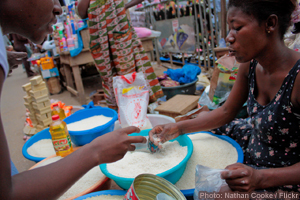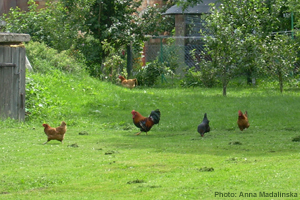While only part of the world’s population is directly involved in producing food, we are all part of the world’s food systems. Whether in the rural areas or in an urban setting, in more or in less industrialised countries, we are all involved – as consumers. What choices do consumers have? Can we, as consumers, contribute towards regional – and more efficient – food systems? Network colleagues look at some of the issues to take into account.
Dawa Sherpa: “More than money”

Bhutan is a predominantly agricultural country, with up to 95 percent of the population involved in farming. But production is not consumer-driven. According to Dawa Sherpa, now working as a livestock research officer with the Ministry of Agriculture and Forests, it is the large wholesalers, retailers and traders who largely determine what is produced and the prices and quantities it is sold at.
“Their business policy is simple: they distribute the country’s foodstuffs, and we are told to buy it, or leave it”. Yet a positive trend has emerged in recent years, with more and more people becoming conscious about their diets and health. This leads them to choose specific products, which encourages local production systems and is slowly contributing to changes in production patterns. “We see that more people prefer domestic products over those grown in India with chemical fertilizers and pesticides, even though these are cheaper”. Naturally, “those with thicker wallets are better able to choose and get what they want”: economic factors still determine much of what is bought.
But money is not the only issue. As Dawa explains, the Bhutanese are willing to go to great lengths to get what they want: “we often identify contacts or friends who help us get the products that we are interested in. We are good at keeping track of these people and knowing where the good products are”. Although large consumer groups do not formally exist yet, these contacts and the strong relationships which are still found between urban and rural areas, can help consumers exert more pressure.
Patrick O. Aboagye: “Taste rules”

Because of Ghana’s open-market economy, consumers (especially in the urban areas) have a wide array of products from which to choose. As elsewhere, money plays a big role, but the selection of one product over another is also based on other criteria. When it comes to a product like meat (chicken, lamb, beef), both rural and urban consumers prefer local products, as these are known to be tastier and healthier, or at least to present less risks. But the opposite is true for one of the most important staple foods: rice. Consumers prefer imported rice, as it is perceived to have a higher quality (aroma and taste). Consumers say they’ll even pay a higher price for it, although it is not always necessary.
Patrick Aboagye, an agricultural engineer working with the Ministry of Food and Agriculture, says that “some of the local rice on the market is more expensive than that brought from abroad, and sometimes it is more difficult to find it. Local rice has a bad image, so it is no wonder that people prefer not to buy it.” The government aims to “revitalise the rice industry” and cut down imports, and has started large projects to support and increase local production (involving the Ghana Rice Inter-Professional Body, the Inland Valley Rice Project and the NERICA Rice Project). There is little doubt, however, that these groups need to dedicate some of their efforts to building a consumption preference for local varieties.
Anna Madalinska: “We need information”

Consumers’ opinions and choices also play an important role in Poland: “We all have a preference for ‘swojskie’, a word that translates as ‘your own’, or ‘from your own farm’”.
According to Anna Madalinska, currently following an MSc programme at the University of Copenhagen, this preference is particularly evident in the summer, when fruits and vegetables are sold on street corners. People prefer to buy here than from a supermarket because they know that what they are buying is a local product, and expect it to be tasty.
However, there are limits to how much choice consumers really have over the goods they buy. As a result of a strong lobbying campaign in favour of GMO crops, more and more farmers are starting to cultivate genetically-modified maize. Reflecting negative public opinion, the President recently vetoed a bill which attempted to expand the list of GMO recipes available in the Polish market beyond those already allowed by the European Union. “Polish consumers tend not to like GMOs.
However, what we find on our shelves also depends on the choices of neighbouring states. Different restrictions in neighbouring countries mean that GMOs will inevitably remain in our products.” As in many other countries, consumers find that they do not have sufficient information about how to identify products containing GMOs, and therefore find it difficult to translate their reservations about GMOs into their purchasing practices. “Consumers need more information.”
